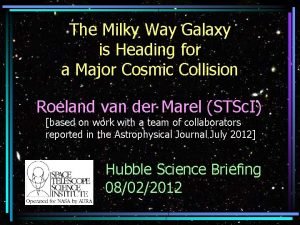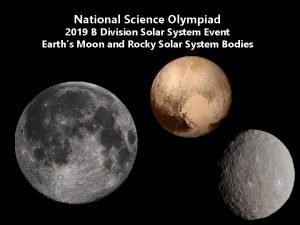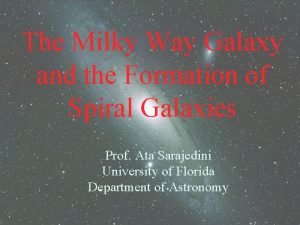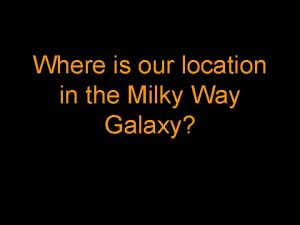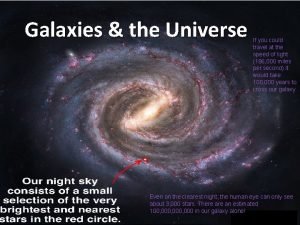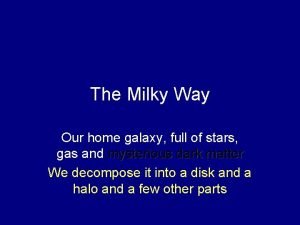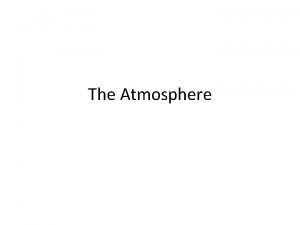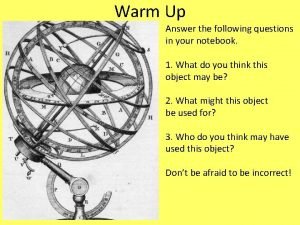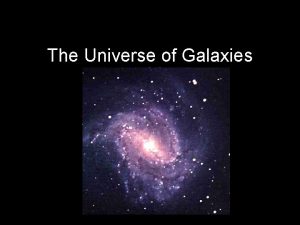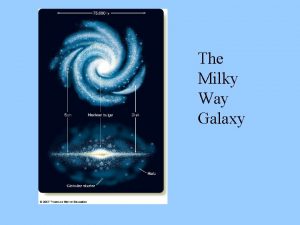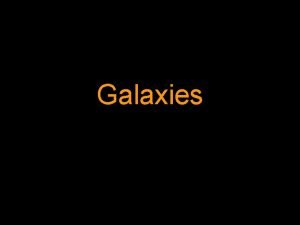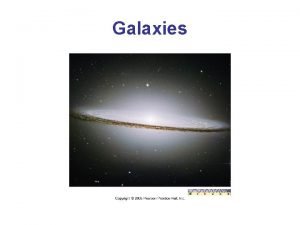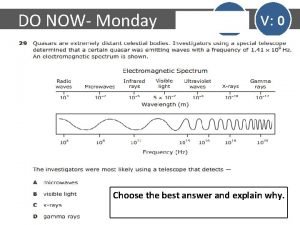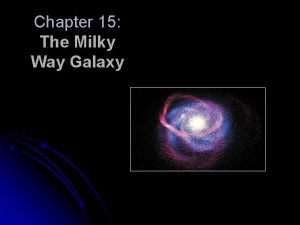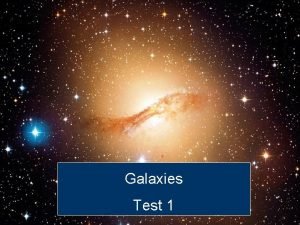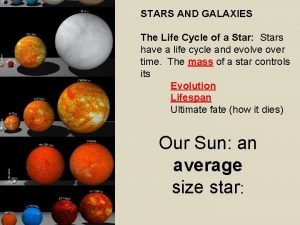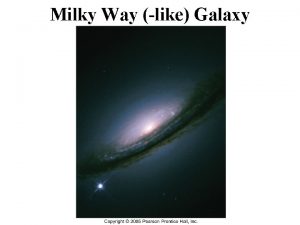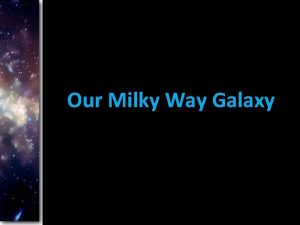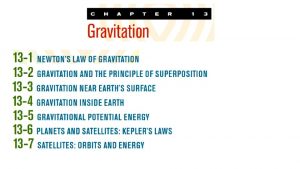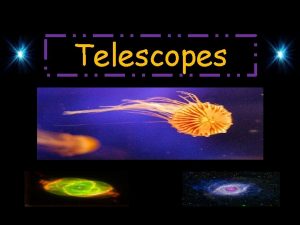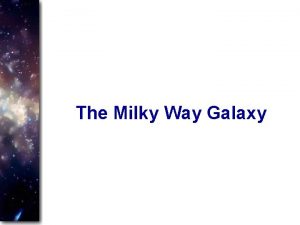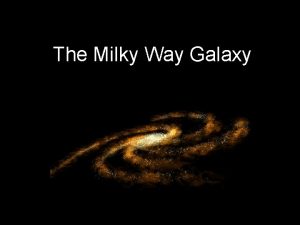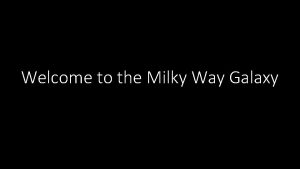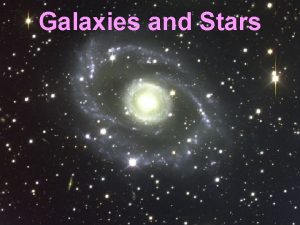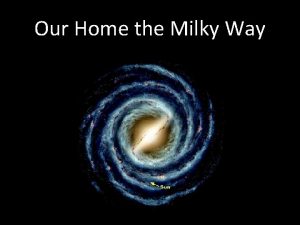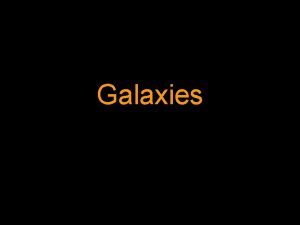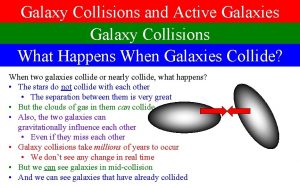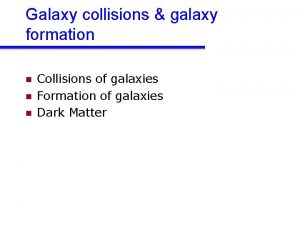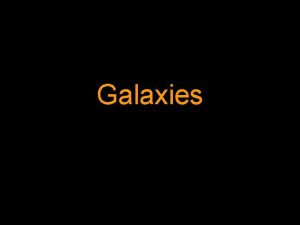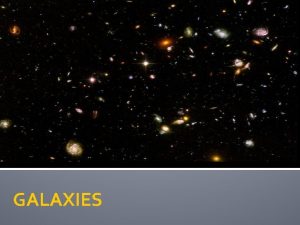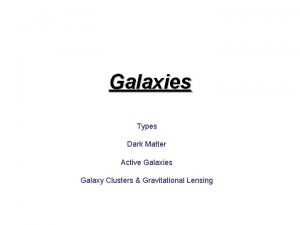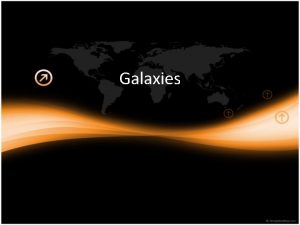Galaxies Wideangle view of our galaxy the Milky







































- Slides: 39

Galaxies

Wide-angle view of our galaxy: the Milky Way.

Schematic diagram of the Milky Way Galaxy, seen from above.

The Structure of Our Galaxy • Our Galaxy has a disk about 100, 000 light-years diameter and about 2000 light-years thick, with a high concentration of interstellar dust and gas. It contains around 200 billion stars. • Interstellar dust obscures our view into the plane of the galactic disk at visual wavelengths. However, hydrogen clouds can be detected beyond this dust by the 21 -cm radio waves emitted by hydrogen in the clouds. Using radio telescopes to study this radio wave emission, we can map out the structure of the galaxy.

The Structure of Our Galaxy • The Milky Way galaxy is a disk with at least four bright arms of stars, gas, and dust which spiral out from the ends of the bar in the galactic nuclear bulge. • Young OB associations, H II regions, and molecular clouds in the galactic disk outline huge spiral arms where stars are forming. • The Sun is located about 26, 000 light-years from the galactic nucleus, between two major spiral arms. The Sun moves in its orbit at a speed of about 828, 000 km/h and takes about 230 million years to complete one orbit around the center of the Galaxy.

Schematic diagram of the Milky Way Galaxy, seen from above.

Mysteries at the Galactic Fringe From studies of the rotation of the Galaxy, astronomers estimate that its total mass is about 1 x 1012 Msun. This is a trillion times the mass of the Sun. Some of the mass is in the stars which are visible, because they are hot and emit visible light. There about 200 billion stars, and most of them are less massive than the Sun, so they are only a fraction of the total mass. (1 trillion = 1000 billion) Much of the remaining mass is still undetectable by any method. Thus it is called dark matter.

This is a sketch of the Milky Way from the side.

There is a larger amount of matter that we can’t see, the dark matter, which extends out much further than the visible Milky Way. The lower part of the figure shows the extent of the dark matter compared to the disk of the Milky Way.

The Structure of Our Galaxy • The center, or galactic nucleus, has been studied at gamma-ray, X-ray, infrared, and radio wavelengths, which pass readily through intervening interstellar dust and H II regions that illuminate the spiral arms. These observations have revealed the dynamic nature of the galactic nucleus, but much about it remains unexplained. • A supermassive black hole of about 4 x 106 Msun exists in the galactic nucleus. (Four million times the Sun’s mass) • The galactic nucleus of the Milky Way is surrounded by a flattened sphere of stars, called the nuclear bulge, through which a bar of stars and gas extends. The entire Galaxy is surrounded by a halo of matter that includes a spherical distribution of globular clusters and field stars, as well as large amounts of dark matter.

Orbits of stars around the Milky Way.

The X-ray pictures of the center of the Milky Way show lots of white dwarfs, neutron stars and ….

We believe that there is a supermassive black hole in the center of the Milky Way galaxy, with a mass of about 4 million solar masses, with an accretion disk. Stars have been seen in orbit around the supermassive black hole in the center of the Milky Way, and their orbits have been studied to deduce the mass of the black hole.

Radio mapping of the motion of stars in the center of the Milky Way. The supermassive black hole has the mass of 4 million Suns. (show ESOcast 2) link

Spiral galaxy classification Compare the number of spirals and the thickness of the bulge

The size of the nucleus varies in spiral galaxies Spiral type a, type b, and type c are classified by the tightness of the spiral arms and the size of the bulge.

The Sombrero galaxy - M 104 – an Sa galaxy

Types of Galaxies • The Hubble classification system groups galaxies into four major types: spiral, barred spiral, elliptical, and irregular. • The arms of spiral and barred spiral galaxies are sites of active star formation. • According to theory of self-propagating star formation, spiral arms of flocculent galaxies are caused by the births and deaths of stars over extended regions of a galaxy. Differential rotation of a galaxy stretches the star-forming regions into elongated arches of stars and nebulae that we see as spiral arms.

Types of Galaxies • According to the spiral density wave theory, spiral arms of grand-design galaxies are caused by density waves. The gravitational field of a spiral density wave compresses the interstellar clouds that pass through it, thereby triggering the formation of stars, including OB associations, which highlight the arms. • Elliptical galaxies contain much less interstellar gas and dust than do spiral galaxies; little star formation occurs in elliptical galaxies.



M 74

M 83


Barred spiral galaxies are classified by the tightness of the spiral arms, like ordinary spiral galaxies.

NGC 1300

Elliptical galaxies have no arms and can be much larger than the Milky Way.

Various elliptical galaxies, with different elongations.

A cluster of ellipticals – Abell 2218

An edge-on Lenticular Galaxy NGC 5866

Irregular galaxies.

A nearby irregular galaxy, site of SN 1987 A.

Hubble’s “tuning fork” model summarizes the types.

Clusters and Superclusters • Galaxies group into clusters rather than being randomly scattered through the universe. • A rich cluster contains at least a thousand galaxies; a poor cluster may contain only a few dozen up to a thousand galaxies. A regular cluster has a nearly spherical shape with a central concentration of galaxies; in an irregular cluster, the distribution of galaxies is asymmetrical. • Our Galaxy is a member of a poor, irregular cluster, called the Local Group. • Rich, regular clusters contain mostly elliptical and lenticular galaxies; irregular clusters contain more spiral and irregular galaxies. Giant elliptical galaxies are often found near the centers of rich clusters.

The Local Group

Superclusters in our neighborhood.

2 d. F Galaxy Survey shows 62, 559 galaxies in two wedges going away from our location. Note the huge voids.

The Virgo supercluster is shown in an interactive map http: //www. atlasoftheuniverse. com/virgo. html This is only part of a larger structure called Laniakea, discovered in 2014. This larger structure may contain over 100, 000 galaxies and is about 500 million light years across. Here is a short (4 min) video describing this research: https: //www. youtube. com/watch? v=r. ENyy. Rwxp. Ho A shorter preview video with different graphics is at http: //vimeo. com/104704518 The observable universe is much larger than the size of this supercluster. Perhaps 50 thousand superclusters like this could fit in the part of the universe that we can see.

Methods used to determine distances.
 Elliptical galaxy
Elliptical galaxy Milky way galaxy sketch
Milky way galaxy sketch Milky way galaxy shape
Milky way galaxy shape Science olympiad solar system
Science olympiad solar system Milky way galaxy
Milky way galaxy Our location in the milky way
Our location in the milky way Jupiler
Jupiler Our home galaxy
Our home galaxy Our home galaxy
Our home galaxy Milky appearance of plasma
Milky appearance of plasma Lime water milky
Lime water milky Dung beetle milky way
Dung beetle milky way Nemertea
Nemertea Where is the solar system located in the milky way
Where is the solar system located in the milky way The milky way
The milky way Democritus milky way
Democritus milky way Milkyway fonterra
Milkyway fonterra Milky way description
Milky way description Pr��ce v cestovn�� kancel����i praha
Pr��ce v cestovn�� kancel����i praha What are galaxies
What are galaxies Tipus de galaxies
Tipus de galaxies Universepg
Universepg Galaxies
Galaxies Brainpop galaxies quiz answers
Brainpop galaxies quiz answers Waves produced by stars and galaxies
Waves produced by stars and galaxies Galaxies lesson plan
Galaxies lesson plan Era of galaxies
Era of galaxies 4 types of galaxies
4 types of galaxies Properties of elliptical galaxies
Properties of elliptical galaxies Life cycle of a galaxy
Life cycle of a galaxy Chapter 30 galaxies and the universe
Chapter 30 galaxies and the universe How are active galaxies classified?
How are active galaxies classified? Evolution of galaxies
Evolution of galaxies Elliptical galaxies facts
Elliptical galaxies facts Our census our future
Our census our future Our awareness of ourselves and our environment is called
Our awareness of ourselves and our environment is called Awareness of ourselves and our environment
Awareness of ourselves and our environment Christ be our light
Christ be our light Our life is what our thoughts make it
Our life is what our thoughts make it God our father christ our brother
God our father christ our brother

